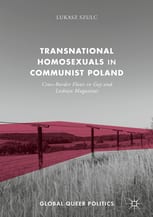Beyond Borders: Sexuality and Cold War: On Łukasz Szulc’s book ‘Transnational Homosexuals in Communist Poland: Cross-Borders Flows in Gay and Lesbian Magazines’.
By Lisa J Walters, on 28 February 2018
Dr Ula Chowaniec (Impacts of Gender Discourse Series)

Transnational Homosexuals in Communist Poland: Cross-Borders Flaws in Gay and Lesbian Magazines. Pelgrave, London 2017.
The Myths, the Archives and the Impact of Community Makings
Łukasz Szulc’s Transnational Homosexuals in Communist Poland is not only about Poland and not only about Communism. It is a carefully executed study on the gay and lesbian movement in the so-called Eastern Bloc, it is a thought-provoking analysis of somehow mythical thinking of what is the “East,” and what kind of myths of the Central and Eastern Europe are particularly harmful, such as the myth of homogeneity; myth of the essence of the region; the teleological myth of good transition from communism into better kind of democracy and the right kind of ethics. Łukasz Szulc discussed all the just mentioned myths as based on one, more general myth of separation of the CEE countries from the West. Łukasz deconstructs those myths taking into account the stories of the emerging queer culture. This book is also an interesting debate on what “queer” means today and how it shapes our global identity and how those identities are used in geopolitical discourses, directly linked to the actual political decisions. The book actually starts with claiming that “we live in the age of ‘queer wars’”, where the issues of body politics, namely position on abortion, divorce and homosexuality divide the countries and people.
Transnational Homosexuals….is also a source of information about “when and where” in the Eastern European LGBT history. In here Łukasz challenges yet another modernist myth of “progress”: he exposes the shortcoming in thinking that the attainment of one political right is a base of another. I quote “When the candidate countries guaranteed the basic LGBT rights and became EU members, it was expected that they would soon introduce further, more far-reaching, LGBT rights. Here, however, the trajectories of different CEE countries have differed substantially. Poland, for example, changed its labour code in 2002 to forbid discrimination based on sexual orientation in employment—one of the conditions of EU accession—and joined the EU in 2004, but has not introduced any other major LGBT rights since then….”
Finally the book is an analysis of almost completely unknown, produced in a very small-scale gay and lesbian magazines, published in the 1980s in Poland: Biuletyn/Etap and Filo. This part of the book opens up to interesting notion of re-writing history through scrupulous research, through devotion to archivist work, finding forgotten, marginalized discourses and making them noticeable and relevant in re-telling of the story of the official history, which is often made of the abovementioned myths, constructed out of cognitive clichés, and full of silences and omissions. Some of those silences (and we know silence is never an absence) Łukasz makes audible.
The part of the book devoted to actual investigation of Polish gay magazines in the 1980s is preceded by the story of the fascinating reports published in Vienna since 1982 on LGBT movement, called the Eastern Europe Information Pool (EEIP), which was for the rest of Europe a source of information about growing LGBT awareness and community. And community here is an important term: the magazines, however small and ephemeral, create a space for development of collective awareness, sense of belonging, the language, the sense of communication. Without any notion of community, the visibility is random, vulnerable, easily appropriated and manipulated by whatever discourse wishes to take it on board.
Therefore, the emergence of Biulety/Etap and Filo with no doubt is an emergence of gay community, gay rather then lesbian, since they are almost inexistent in tthese magazines. And this particular “non existence” brings me to my conclusion, in which I wanted to ask to what extend LGBT movement in Poland or Eastern Europe is organized in communities now? And I hope our talk about Communist Poland will takes us a bit to talking about present time.
The question about the importance of LGBT community I leave partly open, partly commented by quoting a paragraph from Alicja Kowalska’s article (2011) Polish Queer Lesbianism: Sexual Identity Without a Lesbian Community, Journal of Lesbian Studies, 15:3, 324-336, by this quotation I wanted to stress the significance of community:
“Lesbian community had been non-existent during the communist era and is still not distinctly visible in Poland. Twenty years after the change of the political system, a new generation of lesbians—now coming of age—is trying to define their sexualities and find others with whom to identify. Though suppressed by Polish nationalism and social prejudices, lesbian activism has shifted from, and gone beyond, providing mutual support against homophobia, to more diffuse Internet-based social bonding, engagement in political activities, and the use of cultural means of expression. While the Internet provides them with efficient tools of communication, it cannot substitute for real-life contacts or bring a sense of community.”
Łukasz Szulc’s book as well as the Alicja Kowalska’s voice is a search for new history, new inclusive concept of society and new communities. We are in need of them.
 SSEES book launch_beyondbordersv2-2
SSEES book launch_beyondbordersv2-2
The book launch and the discussion on Transnational Homosexuals took place at SSEES on the 24th of October, 2017.
 Close
Close

